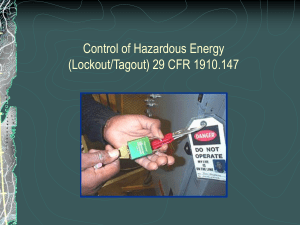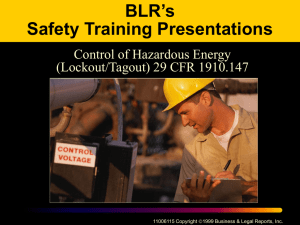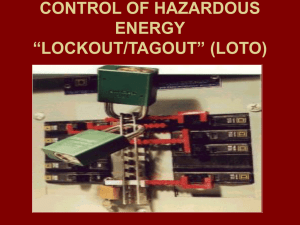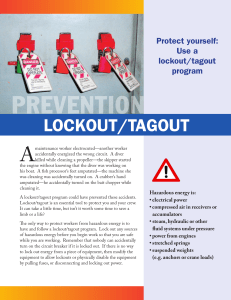Lockout Tagout Program HAZARDOUS ENERGY CONTROL UNIVERSITY OF WASHINGTON
advertisement
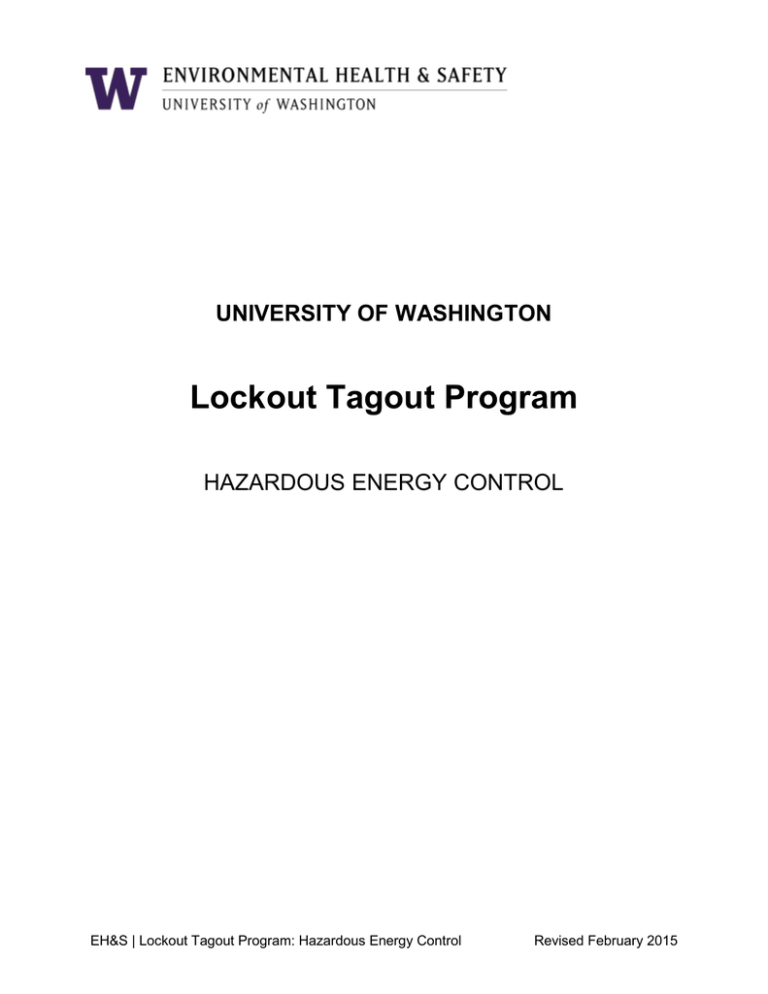
UNIVERSITY OF WASHINGTON Lockout Tagout Program HAZARDOUS ENERGY CONTROL EH&S | Lockout Tagout Program: Hazardous Energy Control Revised February 2015 A. Table of Contents B. PURPOSE ....................................................................................................................... 2 C. SCOPE AND APPLICATION ........................................................................................... 2 D. DEFINITIONS.................................................................................................................. 2 E. RESPONSIBILITIES........................................................................................................ 4 1. Principle Investigators/Project Supervisors/Supervisors .................................................. 4 2. All Personnel ................................................................................................................... 4 3. Authorized Personnel ...................................................................................................... 4 4. Building coordinators and facility managers ..................................................................... 5 5. Outside Contractors......................................................................................................... 5 6. EH&S .............................................................................................................................. 5 F. ADMINISTRATION ............................................................................................................. 5 1. Equipment-specific LOTO procedures. ............................................................................ 5 2. Periodic inspections and record keeping. ........................................................................ 6 3. Locks. .............................................................................................................................. 6 4. Tags. ............................................................................................................................... 6 5. Keys. ............................................................................................................................... 6 6. Group Lockout/Tagout. .................................................................................................... 6 G. TRAINING ....................................................................................................................... 7 H. ENERGY CONTROL PROCEDURES ............................................................................. 7 1. Lockout/Tagout procedures ............................................................................................. 7 2. Returning equipment to service. ...................................................................................... 8 3. Maintaining lockout/tagout continuity. .............................................................................. 8 4. Group Lockout/Tagout. .................................................................................................... 8 5. Group lockout device. ...................................................................................................... 9 6. Lock boxes. ..................................................................................................................... 9 7. Corded and plug connected equipment. .......................................................................... 9 8. Hot tap operations and other energized work. ................................................................10 9. Running adjustments. .....................................................................................................10 10. Testing and positioning procedures. ...........................................................................10 11. Unusual instances requiring lock removal. ..................................................................10 12. Facilities Services electrical utility central system operator procedures. ......................10 13. Procedures for outside personnel/contractors. ............................................................11 EH&S | Lockout Tagout Program: Hazardous Energy Control 1 B. PURPOSE To assure UW personnel safety and prevent personal injury that could result from the unexpected start-up, energization, or release of stored energy during the servicing and maintenance of equipment. The UW Lockout/Tagout (LOTO) Program establishes procedures that are required of all employees including students, staff, and faculty in compliance with Washington State safety regulations, WAC 296-803, and WAC 296-155. As an employer, the University of Washington (UW) must: Develop and implement a formal, written lockout tagout program. Train personnel in the LOTO program. Enforce the program to ensure hazardous energy is controlled during work. The UW LOTO Program describes departmental responsibilities and contains standard procedures to assist departments with compliance. Each Department is responsible for implementing and enforcing its own LOTO procedures and forms that cover the equipment and hazards unique to their area. C. SCOPE AND APPLICATION This program governs the servicing and maintenance of machines and equipment, in which the unexpected start up or energization of the equipment, or release of stored energy, has the potential to cause injury to personnel. Energy sources include electrical, mechanical (hydraulic, pneumatic), chemical, thermal (steam), gravity, electromagnetic fields, as well as other sources of energy. This program applies to all UW-owned, leased or operated facilities. All UW personnel and contractors under UW control must comply with this program. This program does not apply aboard maritime vessels operated by University personnel, which are subject to Federal regulations pertaining to workplace safety. This document is the written LOTO program for the University of Washington and can be used by departments with or without written LOTO programs. However, some departments may be adhering to existing department-specific LOTO programs. In either case, departments may choose to either: Follow and use this program for specific department needs. Develop, maintain, and follow a department-specific written LOTO program that meets regulatory requirements. D. DEFINITIONS Affected Person: UW faculty, staff, employee, or student who is required to operate, use, or be in the area where a machine or equipment could be locked or tagged out for service or maintenance. Affected personnel are not authorized to perform lockout/tagout. Authorized Person: UW faculty, staff, employee, or student who is qualified by proper training and has been given the authority and responsibility to perform a specific lockout/tagout-related task by his or her supervisor. Such authority and responsibility includes de-activating and locking out equipment and systems in compliance with this program. Capable of being locked out: An energy-isolating device is considered capable of being locked out if it: Is designed with a hasp or other means of attachment to which a lock can be affixed. Has a built-in locking mechanism. EH&S | Lockout Tagout Program: Hazardous Energy Control 2 Can be locked without dismantling, rebuilding, or replacing the energy-isolating device or permanently altering its energy control capability Central system operator: A designated Authorized Person responsible for the exclusive control of energy isolating devices installed on an electrical utility system. Please refer to Section XV of the Facilities Services Lockout/Tagout Safety Program for more information. Energized: Connected to an energy source, or containing residual or stored energy. Energy isolating control or device: A mechanical device that physically prevents the transmission or release of energy. This includes, but is not limited to the following: Manually operated electrical circuit breakers Disconnect switches Manually operated switches that disconnect the conductors of a circuit from all ungrounded supply conductors if no pole of the switch can be operated independently Line valves Blanks, blinds, blocks, or similar devices that are used to block or isolate energy Removal of wires or sections of pipe Installation of blocks, wedges and cribbing Similar devices used to block or isolate energy. Push buttons, selector switches and other control circuit type devices are not energy isolating devices. Energy source: Any source of electrical, mechanical (hydraulic, pneumatic), chemical, thermal, or other energy. Equipment protection lock: A lock used to prevent the unauthorized operation of equipment. Equipment protection locks are not considered lockout devices. Hasp: A group lockout/tagout device able to accept multiple locks and tags. The device is secured to energy isolating controls or devices and has multiple points of attachment for locks and tags. Group Lock box: A method of maintaining a lockout/tagout procedure when more than one person is involved. The lock box is used to store any keys used in the lockout/tagout procedure until the job is complete. Hazardous energy: Energy that could cause harm to personnel, such as electricity, high-intensity electromagnetic fields, chemical, radiation, and mechanical sources. Mechanical sources of energy include gravity, pneumatic, hydraulic, compression, spring tension, and pressurized systems. Hot tap: A procedure which involves welding on pressurized pipelines, vessels, or tanks to install connections or accessories. The procedure is commonly used to replace or add sections of pipeline used in air, gas, water, steam and chemical distribution systems without interrupting service. Lockout: The placement of a lockout device on an energy-isolating device in accordance with an established procedure. The lockout procedure ensures that the energy-isolating device and the equipment being controlled cannot be operated until the lockout device is removed. Lockout device: Any device that uses positive means, such as a lock, blank flanges and bolted slip blinds, to hold an energy-isolating device in a safe position, thereby preventing the energizing of machinery or equipment. Primary Authorized Person: An authorized faculty, staff, employee or student who has overall responsibility for meeting the requirements of the lockout/tagout procedures when working in a group. The Primary Authorized Person will attach a lock and tag when the equipment is de-energized before work begins and will be the last person to remove their lock and tag when the job is completed. EH&S | Lockout Tagout Program: Hazardous Energy Control 3 Servicing or maintenance: Workplace activities such as constructing, installing, setting up, adjusting, inspecting, modifying, maintaining or servicing machines or equipment. This includes lubrication, cleaning or unjamming of machines or equipment, and making adjustments or tool changes, where employees could be exposed to the unexpected energization or startup of the equipment or release of hazardous energy. Tagout: The placement of a tagout device on an energy-isolating device, in accordance with an established procedure, to indicate that the energy-isolating device and the equipment being controlled may not be operated until the tagout device is removed. Tagout device: Any prominent warning device, such as a tag and a means of attachment that can be securely fastened to an energy-isolating device to indicate that the machine or equipment to which it is attached may not be operated until the tagout device is removed. E. RESPONSIBILITIES 1. Principle Investigators/Project Supervisors/Supervisors Principle investigators/Project Supervisors/Supervisors are responsible for: Informing all faculty, staff, students, work personnel and hired-in Contractors working in the area (Affected Personnel) of the existence of this program and its impact on their work area. Determining which Authorized Personnel may work on the equipment. Ensuring that all students, staff, faculty, or other employees have had documented LOTO training at an appropriately anticipated level of exposure to hazardous energy sources in their research or workplace. Ensuring that proper labeling is applied to all shutoff locations on equipment controlled by the department. Labeling activities may be conducted by the PI, Supervisor or Authorized Personnel, another department member under the leadership of this person, or by an outside contractor. Conducting an annual audit of equipment-specific energy isolation procedures to ensure they are accurate and appropriate. An annual review should also be conducted for all Authorized Personnel to assess their understanding of Lockout/Tagout procedures. Ensuring that employees adhere to LOTO procedures when performing servicing or maintenance. Contact EH&S for assistance in developing energy isolation procedures and providing training to faculty, staff, employees, students, and Authorized Personnel as needed. 2. All Personnel All personnel, including Affected Personnel, are responsible for: Understanding that no person should ever touch or try to actuate an energy source that has been locked and tagged in the off position by someone else. Understanding and following instructions from Authorized Personnel. Seeking out trained, designated and Authorized Personnel to service and maintain equipment that possess an energy source that could potentially be hazardous to personnel if LOTO procedures are not followed. Ensuring that all incidents and near misses involving the release of hazardous energy are reported to their supervisor as soon as possible. Ensuring that all incidents and near misses are reported using the Online Accident Reporting System (OARS). 3. Authorized Personnel Authorized Personnel are responsible for: Establishing and writing machine or equipment specific LOTO procedures. EH&S | Lockout Tagout Program: Hazardous Energy Control 4 Following LOTO procedures whenever working on applicable equipment. Reporting the presence of equipment for which LOTO procedures have not been established and which pose a potential for injury should an unexpected start-up, energization or release of stored energy occur during servicing or maintenance. Removing personal protection locks and tags. This must occur when: (1) Authorized Personnel are not working on the equipment. (2) A work shift ends. (3) A project ends. Verifying that people in the area that are not part of the LOTO work team understand that they are Affected Personnel prior to the start of the LOTO procedure. Communicating and coordinating LOTO efforts with all Affected Personnel, departmental building coordinators, and facility managers. 4. Building Coordinators and Facility Managers Building coordinators and facility managers are responsible for: Understanding when equipment and systems need to be locked and tagged out for service and maintenance. Collaborating with Authorized Personnel and facilitating LOTO efforts, including the notification of Affected Personnel. 5. Outside Contractors Outside Contractors are responsible for: Providing applicable UW departments with company accepted LOTO program and policies. Providing own energy isolation equipment including locks, tags, and hasps. Ensuring that lockout devices that have been put in place are only removed by the Authorized Personnel who placed them. Following any previously developed University department equipment-specific LOTO procedures for equipment the contractor is servicing. If no equipment-specific LOTO procedures have been previously developed, the UW Supervisor and outside contractor will assess the equipment and develop an equipment specific LOTO procedure. 6. EH&S EH&S is responsible for: Developing, coordinating, and maintaining the UW LOTO Safety Program in accordance with DOSH and OSHA standards. Providing consultation and assistance to departments to comply with the requirements of this program. Providing or coordinating LOTO training to Authorized Personnel. Annual review of the LOTO program for accuracy and ensuring compliance with regulatory requirements and current industry best practices. F. ADMINISTRATION 1. Equipment-specific LOTO procedures Written procedures are required when: The equipment has more than one energy source EH&S | Lockout Tagout Program: Hazardous Energy Control 5 The equipment has energy sources that are not obvious The equipment stores energy or can accumulate energy after shut down More than one device is required to lock out the equipment The machine or equipment has not previously been isolated from the energy source and locked out during service or maintenance The lockout device is not able to be under the exclusive control of the employee working on the equipment The work creates a hazard to other personnel There has been a previous accident involving unexpected activation of the equipment Equipment-specific LOTO procedures must be written by Authorized Personnel with knowledge of the operation of the equipment being locked out. The procedures for restoring normal operations must be included in the procedures. If a group lockout will take place, then a Primary Authorized Personnel must review the procedure to assure that it is accurate and complete before the lockout/tagout begins. Any modifications to the procedure must be added to the document. 2. Periodic inspections and record keeping Each department must review written LOTO procedures for accuracy at least annually. The periodic inspections must also include an evaluation of Authorized Personnel knowledge of established procedures. Periodic inspections must be documented. Documentation of this program, audit, training records, etc., must be kept in the department files. 3. Locks All personnel locking out equipment must use locks designated for LOTO. Departments must use locks that are standardized and designated for LOTO by color, shape, or size. Combination locks may not be used for LOTO, and personal protection locks may not be used for anything unrelated to lockout/tagout. Each LOTO lock will be issued with only one key. Any lock used for lockout/tagout should be identified as a personal protection lock. Each lock should include the user's name and contact telephone number. 4. Tags Tags must not be used alone or in place of lockout devices unless there is no feasible method of isolating energy sources. If it is not possible to use a lockout device, a tag is still required. The LOTO procedures listed in section G must be followed when using a tag. In addition, extra control methods must coincide with placement of a tag. Some of those extra control methods include physically blocking a switch, removing a control handle, or removing part of a circuit or pipe. Tags should state the words DANGER: Do Not Operate, or similar phrasing. Tags should also include the following information: Reason for the lockout Name of the person(s) performing the servicing or maintenance Contact information for the person who applied the tag Date and time the tag was put in place 5. Keys Keys to personal protection locks must be in possession of the individual who applied them whenever an employee is working on the locked out equipment. 6. Group Lockout/Tagout Jobs involving more than one employee must be locked out by a lockout/tagout crew of Authorized Personnel. One member of the lockout/tagout crew must be designated as the Primary Authorized Person. When a shutdown includes work performed by non-university EH&S | Lockout Tagout Program: Hazardous Energy Control 6 personnel, the lockout/tagout crew must include a supervisor from each employer. See also Group Lockout/Tagout Procedures section G.4. G. TRAINING LOTO training must be provided to all Affected and Authorized Personnel. 1. Affected Personnel must receive training on the purpose and use of the energy control procedure. 2. Authorized Personnel must receive training on the recognition of situations involving hazardous energy, recognition of safety locks and tags, and what UW policies and procedures are in place. The objectives of this training must: Ensure UW personnel understand the purpose and function of the LOTO program Provide the knowledge and the skills necessary to carry out program responsibilities Ensure Authorized Personnel will be able to recognize hazardous energy sources, and have the methods and means to isolate and control energy Give an explanation of the use of lockout procedures to be used on the job Give a clear understanding that attempting to restart or reenergize equipment that is locked and tagged out is never allowed Inform Authorized Personnel that tags are warning devices that do not provide the same level of protection as a lock. Tags are a secondary measure. However, tags should be treated as lockout devices such that they should only be removed by the person who placed it. Communicate the need to inform and communicate with all Affected Personnel prior to starting work requiring LOTO procedures Regardless of the training source, the department employing the faculty, staff, employee, or student is responsible for keeping documentation of all training. Documentation must include the name of trained employees and the date of training. LOTO training is required for any personnel prior to using LOTO procedures. The training should be refreshed as required when regulations change, processes change, or when the department has reason to believe that refreshing the training is necessary to maintain a safe LOTO practice. H. ENERGY CONTROL PROCEDURES 1. Lockout/Tagout procedures Identify all energy sources: The Supervisor or Authorized Personnel identifies all energy sources requiring energy isolation applicable to the service and maintenance to be performed. Notify affected personnel: The Authorized Personnel checks to be sure that no one is operating the machinery before turning off energy sources. All persons in the area, and especially the machine operator and project supervisor, are informed before the energy sources are being turned off. Unexpected, sudden loss of power could cause significant injury. Shut down equipment or system to be serviced using normal stopping procedures. Dissipate or restrain stored energy: o Steam, air, and hydraulic piping or tanks must be bled, drained, and brought to atmospheric pressure and locked “open” to assure no pressure or vacuum in piping or in reservoir tanks. o Gas cylinders must be locked ‘closed’ and if possible disconnected from distribution piping. EH&S | Lockout Tagout Program: Hazardous Energy Control 7 o Any mechanical component that could roll, shift or move, such as springs, counterweights, wheels, fan blades, etc. must be chained, barred or blocked. Place locks and tags: Each person who will be working on the machinery must put a lock on each of the machine’s energy isolating device(s). Each lock must remain on the machine until the work is completed. Only the worker who placed the lock may remove their lock. Attach accident prevention tags, which give the reason for placing the lock and tag, the name of the person placing the lock and tag, how they may be contacted, the date, and time the lock and tag was placed. Verify (tryout): After ensuring all personnel are clear, verify that the equipment or system is isolated by attempting to energize it. Make sure all controls are returned to the off or neutral position. Do not repeat verification of LOTO while service and maintenance is being performed. For procedures involving one person, the procedure can be verified by the person locking and tagging out the equipment or system. Group LOTO procedures must have an assigned Primary Authorized Person to verify the procedure. 2. Returning equipment to service Ensure all personnel are clear of the work area. Ensure all tools are removed from work area. Reinstall all guards. Have each Authorized Personnel remove their own lock and tag from all energy isolation devices. Notify all Affected Personnel that lockout devices have been removed, and that the system or equipment will be restarted. Return the equipment or system back to normal service. 3. Maintaining lockout/tagout continuity If a system or piece of equipment will be left unattended, in an inoperable condition at the end of a shift, or if an oncoming shift will be continuing work on the system, follow one of these methods: 1. A site supervisor or designated Primary Authorized Person will facilitate lockout/tagout continuity. This must be done by replacing the departing shift employee’s lock and tag with his or her personal lock and tag on the system until work continues. This method should be used if there will be a break in time between work shifts. OR 2. Authorized Employee(s) from the oncoming shift will place personal locks and tags on the system or equipment before the departing shift removes their personal locks and tags. This method is preferred, if feasible. Regardless of which method is used, The Primary Authorized Personnel must verify that the equipment or system remains inoperable in a manner similar to Step 9 in the lockout/tagout procedure. “Shop locks” or equipment locks with multiple keys may not be used to maintain lockout/tagout continuity. 4. Group Lockout/Tagout Some servicing or maintenance work may involve a group or groups of employees. When more than one person is involved in a lockout/tagout procedure, group lockout/tagout procedures must be followed. Any hazardous energy control method used for a group must provide an equivalent level of protection as would the use of personal lockout/tagout devices. A Primary Authorized Person must be assigned to provide oversight for any procedure involving more than one person. The Primary Authorized Person will: Have overall responsibility for the servicing or maintenance of the equipment. EH&S | Lockout Tagout Program: Hazardous Energy Control 8 Verify that the LOTO procedure was completed correctly by attempting to startup the equipment or system. Be the last person to remove his or her lockout device once the servicing or maintenance is finished. The following methods can be used to effectively isolate hazardous energy when multiple people are involved: 5. Group lockout device When an energy-isolating device for equipment or machinery cannot accept more than one lock and tag, a group lockout device, such as a hasp, may be used. Hasps should be used when lockout/tagout procedures are not complex and require only one energy source to be locked and tagged out. When using a hasp, each Authorized Person should attach personal tags to individual locks rather than attaching them directly to the hasp device. 6. Lock boxes When energy isolation is complex and requires lockout/tagout for multiple energy sources, lock boxes are an appropriate method of energy control. Using lockboxes protects multiple Authorized Personnel without having each person apply a personal lock on an energy isolation device. This is especially practical when energy isolation devices are widely dispersed, or if there are many different employers working on the same equipment or system. If using a lock box, locks used for the group LOTO procedures will be designated by color, size, or shape. Once a lock box is in use, the key for the group locks will be placed in the box. The box must be secured by appropriate means. Lock boxes should be secured by the Primary Authorized Person’s lock, the locks of the Authorized Persons, or a tamper evident seal. The following are requirements that must be considered when using a lockbox: Individual assigned locks will not be placed on the equipment. Instead, locks designated for group lockouts will be used to lock out the equipment or system. The group LOTO procedures must provide each Authorized Personnel with the same level of control that he or she would be afforded in an individual LOTO scenario. All hazardous energy sources must be isolated and controlled prior to placing individual locks and tags on group lock boxes. There must be a Primary Authorized Person (PAP) designated to review the LOTO procedure and ensure the procedure indicates a plan to use a lockbox. This employee will be the first person to place their lockout device on the lock box, and the last person to remove their lockout device from the lock box. The Primary Authorized Person must physically verify each step of the LOTO procedure and sign the form. The PAP must also tryout the equipment or system to ensure that the hazardous energy is controlled. Between shifts, the lock box must be secured appropriately. The Primary Authorized Person must ensure that the lock box is secured until the job is complete. If the lock or seal on the lock box is not maintained, the entire LOTO effort must be considered failed, all work stopped and the entire LOTO process started over again. 7. Corded and plug connected equipment Making corded and plugged equipment safe for servicing and maintenance can be done in one of the following ways: The Authorized Personnel must have exclusive control of the plug when disconnected from the energy source. This is often called the “cord in hand method” and is acceptable only if any stored energy in the equipment cannot be reasonably expected to be dissipated through the plug. EH&S | Lockout Tagout Program: Hazardous Energy Control 9 A lockout device can be used to prevent someone from connecting the plug to a power source. 8. Hot tap operations and other energized work Work on energized systems must not be done unless it is impossible to de-energize a system because it is not feasible or the service is essential. Examples are typically limited to life support systems and fire protection systems in certain circumstances. 9. Running adjustments Running adjustments cannot be used unless the equipment or system cannot be adjusted while it is locked out. Running adjustment procedures will be considered an alternative method to controlling the release of hazardous energy and the process must be completely documented, much the same as a routine LOTO procedure. Departments are responsible for providing the expertise for and the documentation of running adjustment procedures. In all cases, running adjustments must be routine in nature, repetitive, and integral to using the system or equipment. And in all cases, another suitable means of protection must be provided. 10. Testing and positioning procedures When LOTO devices must be temporarily removed from the energy isolating device and the machine or equipment energized to test the machine or equipment, the following sequence of actions must be followed: Remove personnel from the machine or equipment Clear the machine or equipment of tools and materials Remove the lockout and tagout devices Energize and proceed with testing or positioning De-energize all systems and reapply energy control measures to continue the servicing or maintenance 11. Unusual instances requiring lock removal Under normal circumstances, the person who placed the lock is the person to remove their lock. Occasionally, this is not possible. Removal of another person’s lock must follow the process of placing equipment or systems back into normal service. Departments are responsible for documenting a process for removing a lock when the lock’s owner is not able to do so. A Lock Removal Form should be used when a lock is removed in these situations. 12. Facilities Services electrical utility central system operator procedures A Central System Operator must be appointed when following energy control procedures for the electrical utility system. Equipment-specific procedures for electrical utility systems should reflect any Washington Administrative Code (WAC) and Facilities Services requirements. Please refer to Section XV of the Facilities Services Lockout/Tagout Safety Program for more information. See also WAC 296-45 (Safety Standards for Electrical Workers). If energy isolating devices are installed in a central location under the exclusive control of a system operator, the following requirements apply: 1. The employer must use a procedure that affords employees a level of protection equivalent to that provided by the implementation of a personal lockout or tagout device. 2. The system operator will place and remove lockout and tagout devices in place of the authorized employee. 3. Provisions will be made to identify the authorized employee who is responsible for (that is, being protected by) the lockout or tagout device, to transfer responsibility for lockout and tagout devices, and to ensure that an authorized employee requesting removal or transfer of a lockout or tagout device is the one responsible for it before the device is removed or transferred. EH&S | Lockout Tagout Program: Hazardous Energy Control 10 13. Procedures for outside personnel/contractors All outside personnel/contractors who will perform work requiring energy control methods must be informed of all university lockout/tagout safety program requirements. The outside employer must ensure that outside employees understand and comply with all elements of the UW lockout/tagout safety program. In addition, the outside employer must also inform the university department of their company’s lockout/tagout procedures. Contractors must follow UW equipment-specific procedures. If there are no existing equipment-specific procedures, procedures must be developed with UW Authorized Personnel prior to locking and tagging out equipment. Adopted by: Department: Reviewed on (Mo/Yr): Authorized Users EH&S | Lockout Tagout Program: Hazardous Energy Control Training Date 11
